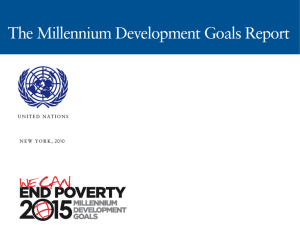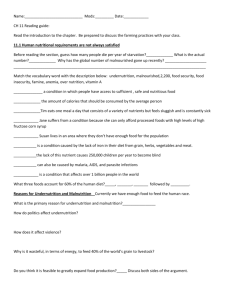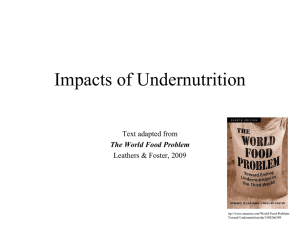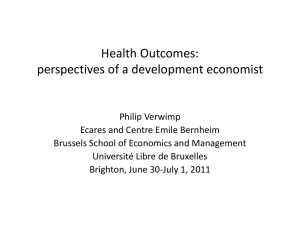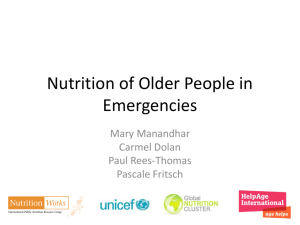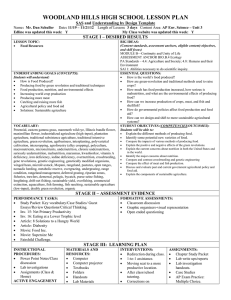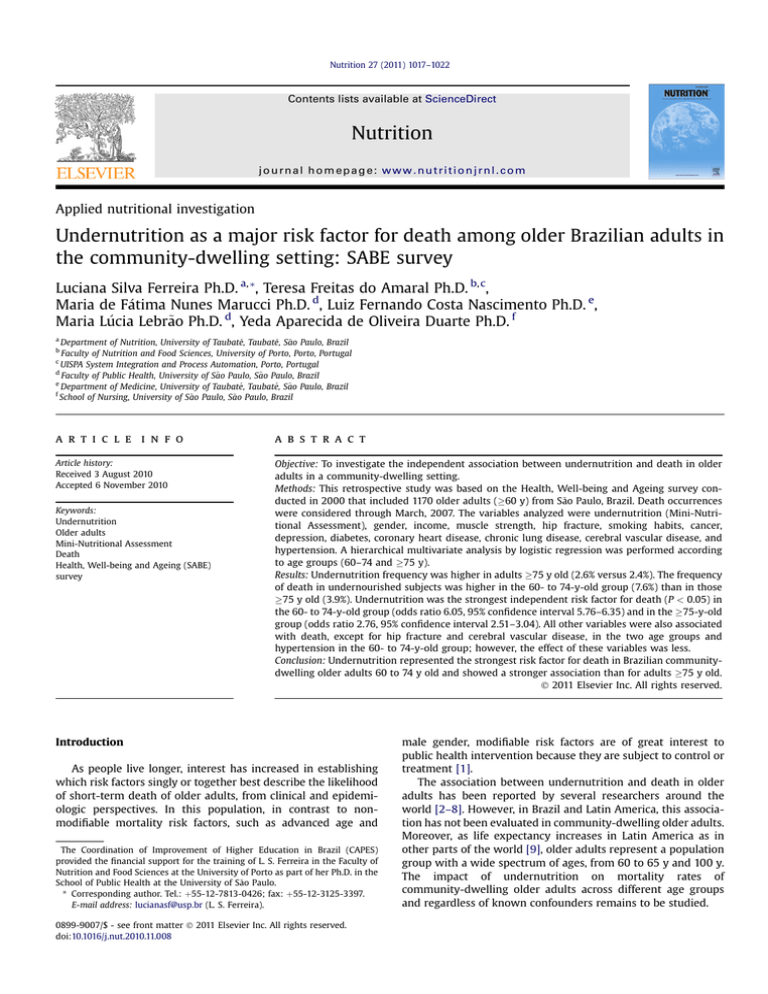
Nutrition 27 (2011) 1017–1022
Contents lists available at ScienceDirect
Nutrition
journal homepage: www.nutritionjrnl.com
Applied nutritional investigation
Undernutrition as a major risk factor for death among older Brazilian adults in
the community-dwelling setting: SABE survey
Luciana Silva Ferreira Ph.D. a, *, Teresa Freitas do Amaral Ph.D. b, c,
tima Nunes Marucci Ph.D. d, Luiz Fernando Costa Nascimento Ph.D. e,
Maria de Fa
cia Lebra
~o Ph.D. d, Yeda Aparecida de Oliveira Duarte Ph.D. f
Maria Lu
~o Paulo, Brazil
Department of Nutrition, University of Taubat
e, Taubat
e, Sa
Faculty of Nutrition and Food Sciences, University of Porto, Porto, Portugal
UISPA System Integration and Process Automation, Porto, Portugal
d
~o Paulo, Sa
~o Paulo, Brazil
Faculty of Public Health, University of Sa
e
~o Paulo, Brazil
Department of Medicine, University of Taubat
e, Taubat
e, Sa
f
~o Paulo, Sa
~o Paulo, Brazil
School of Nursing, University of Sa
a
b
c
a r t i c l e i n f o
a b s t r a c t
Article history:
Received 3 August 2010
Accepted 6 November 2010
Objective: To investigate the independent association between undernutrition and death in older
adults in a community-dwelling setting.
Methods: This retrospective study was based on the Health, Well-being and Ageing survey conducted in 2000 that included 1170 older adults (60 y) from S~
ao Paulo, Brazil. Death occurrences
were considered through March, 2007. The variables analyzed were undernutrition (Mini-Nutritional Assessment), gender, income, muscle strength, hip fracture, smoking habits, cancer,
depression, diabetes, coronary heart disease, chronic lung disease, cerebral vascular disease, and
hypertension. A hierarchical multivariate analysis by logistic regression was performed according
to age groups (60–74 and 75 y).
Results: Undernutrition frequency was higher in adults 75 y old (2.6% versus 2.4%). The frequency
of death in undernourished subjects was higher in the 60- to 74-y-old group (7.6%) than in those
75 y old (3.9%). Undernutrition was the strongest independent risk factor for death (P < 0.05) in
the 60- to 74-y-old group (odds ratio 6.05, 95% confidence interval 5.76–6.35) and in the 75-y-old
group (odds ratio 2.76, 95% confidence interval 2.51–3.04). All other variables were also associated
with death, except for hip fracture and cerebral vascular disease, in the two age groups and
hypertension in the 60- to 74-y-old group; however, the effect of these variables was less.
Conclusion: Undernutrition represented the strongest risk factor for death in Brazilian communitydwelling older adults 60 to 74 y old and showed a stronger association than for adults 75 y old.
Ó 2011 Elsevier Inc. All rights reserved.
Keywords:
Undernutrition
Older adults
Mini-Nutritional Assessment
Death
Health, Well-being and Ageing (SABE)
survey
Introduction
As people live longer, interest has increased in establishing
which risk factors singly or together best describe the likelihood
of short-term death of older adults, from clinical and epidemiologic perspectives. In this population, in contrast to nonmodifiable mortality risk factors, such as advanced age and
The Coordination of Improvement of Higher Education in Brazil (CAPES)
provided the financial support for the training of L. S. Ferreira in the Faculty of
Nutrition and Food Sciences at the University of Porto as part of her Ph.D. in the
School of Public Health at the University of S~
ao Paulo.
* Corresponding author. Tel.: þ55-12-7813-0426; fax: þ55-12-3125-3397.
E-mail address: lucianasf@usp.br (L. S. Ferreira).
0899-9007/$ - see front matter Ó 2011 Elsevier Inc. All rights reserved.
doi:10.1016/j.nut.2010.11.008
male gender, modifiable risk factors are of great interest to
public health intervention because they are subject to control or
treatment [1].
The association between undernutrition and death in older
adults has been reported by several researchers around the
world [2–8]. However, in Brazil and Latin America, this association has not been evaluated in community-dwelling older adults.
Moreover, as life expectancy increases in Latin America as in
other parts of the world [9], older adults represent a population
group with a wide spectrum of ages, from 60 to 65 y and 100 y.
The impact of undernutrition on mortality rates of
community-dwelling older adults across different age groups
and regardless of known confounders remains to be studied.
1018
L. S. Ferreira et al. / Nutrition 27 (2011) 1017–1022
The Mini-Nutritional Assessment (MNA) is a multidimensional and validated method for the assessment of nutritional
status of older adults, and its use overcomes the methodologic
problems related to different assumptions that are used to
diagnose undernutrition; MNA also provides a solid basis to
compare estimates with other populations [10–12]. To our
knowledge, the independent association between undernutrition and death in community-dwelling older adults by age group
has not been previously evaluated using the MNA and remains to
be quantified.
Most studies concerning the association between risk factors
and outcomes use multivariate analysis as a statistical approach.
In these studies, the decision about which risk factors are to be
included in the multivariate model was based purely on the
statistical association between variables. However, as was
previously suggested by Victora et al. [13–15], the complex
hierarchical interrelations between the determinants of
outcomes are best managed through the use of conceptual
frameworks, where the decision on which factors to include in
the statistical model is based on the hierarchical relations among
them. However, logistic regression hierarchical analysis has not
been previously used to explore the association between
undernutrition and death in older adults.
This study aimed to investigate the independent association
between undernutrition and death in older Brazilian adults
across age groups in a community-dwelling setting using
a hierarchical logistic regression model.
Materials and methods
Design and participants
This study is a retrospective analysis of a random population sample of
community-dwelling older adults (60 years) who participated in the Health,
~o Paulo, Brazil in 2000. The
Well-being and Ageing (SABE) survey in the city of Sa
SABE survey, a multicenter study coordinated by the Pan-American Health
Organization, aimed to investigate the living and health conditions of older
adults in seven cities in Latin America and the Caribbean: Bridgetown, Barbados;
Buenos Aires, Argentina; Mexico City, Mexico; Havana, Cuba; Montevideo,
Uruguay; S~
ao Paulo, Brazil; and Santiago, Chile [16].
The design and methodologic details of the SABE survey in Brazil have been
previously reported [16]. Briefly, the sample consisted of 2143 community~o Paulo and was based on the
dwelling older adults living in the urban area of Sa
population register of the Brazilian Institute of Geography and Statistics of 1996.
This random sample was composed of 1568 older men and women combined with
another random sample of 575 elders taken from a pool of older men and women
75 y old. The combined group corresponded to the enlarged sample (of free
composition) and attempted to compensate for the lower population density of
the older (75 y) group. To offset the higher mortality rate in older men, the
sample was also adjusted for male compared with female gender [16].
The sample was identified through the cluster-sampling method in two
stages. Households were randomly selected using division in proportion to the
size of the sample criteria based on 72 census tracts. To adjust sample distribution according to the composition of the population, weights were calculated for
each age group, gender, and census sector and the sample weight was taken into
account during data analysis.
Two inclusion criteria were considered: participation in the SABE survey in
2000 and availability of information for all studied variables. This study included
1170 older adults (498 men and 672 women). The participants (54.6% of the initial
sample) differed from non-participants in age, cerebral vascular disease, and death
(P < 0.01). Among the non-participants there was a larger proportion of older
adults 75 y old (26.8% versus 18.4%) and deaths (37.6% versus 22.6%) and a smaller
proportion of older adults with cerebral vascular disease (9.6% versus 5.3%).
Data collection and study variables
The data for the SABE survey were obtained by previously trained health
professionals and nutrition trainees in household interviews using a questionnaire with 11 sections: personal data, cognitive assessment, health status, functional status, medication, use and access to health services, family and social
support network, employment history and sources of income, characteristics of
housing, anthropometry, flexibility, and mobility. Eighty-eight percent of
interviews were performed directly with the subjects and the remaining interviews were conducted through a proxy.
The occurrence of death was verified by the Mortality Information System of
the municipality of S~
ao Paulo, Brazil, taking into consideration cases through
March 2007, although the study was completed in June 2009.
Undernutrition was assessed by the MNA (total score <17 points). Older adults
at risk of undernutrition were identified through a MNA score from 17 through
23.5 [10]. This is a multidimensional method and is composed of 18 items,
including anthropometric characteristics, feeding, cognitive status, functional
status, living conditions, medication use, presence of skin lesions or scabs, selfperception of health, and nutrition. Because information about the presence of
skin lesions or scabs (question I) was not investigated in the SABE survey, a score of
1 was given for all participants. Dementia (question E) was identified using the
Mini-Mental State Examination as modified and validated by Icaza and Albala [17].
Weight and height measurement techniques (question F) were performed
according to the method of Frisancho [18]. Upper arm circumference (question Q)
and calf circumference (question R) were measured according to the method of
Callaway et al. [19]. All measurements were performed in triplicate and the
average value used was for the analysis. Some adaptations were made to complete
the MNA to accommodate the food habits of the Brazilian population. Regarding
selected consumption markers for protein intake (question K), an affirmative
answer was assigned if adults consumed pulses or eggs at least once a day and ate
two or more servings of meat, fish, or poultry per week.
The control explanatory variables were gender (female, male), income for
daily living (insufficient, sufficient), hypertension (no, yes), diabetes (no, yes),
chronic pulmonary disease (no, yes), coronary disease (no, yes), cancer
(no, yes), cerebral vascular disease (no, yes), hip fracture (no, yes), depression
(no, yes), smoker (no, yes), and low muscle strength (no, yes). All variables were
self-reported by older adults, except low muscle strength and depression.
Hip fracture occurrence was considered when it occurred in the 12 mo before
the interview. Depression was evaluated with the Geriatric Depression Scale [20].
Muscle strength was measured in the dominant hand, from the maximal value of
three consecutive evaluations, using a handgrip dynamometer (TK 1201 model;
Takei Scientific Instruments Co. Ltd, Niigata-City, Japan). It was classified as low
when the values were below the 10th percentile from the reference data of
~o Paulo,
Barbosa et al. [21], which were developed for individuals in the city of Sa
Brazil.
The SABE survey and the present study were approved by the research ethics
committee of the Faculty of Public Health at the University of S~
ao Paulo and by
the Brazilian National Research Ethics Committee. All the participants gave their
informed consent to participate in the study.
Statistical analysis
Descriptive analysis was used to characterize the population and the sample
data were stratified according to age groups 60 to 74 y and 75 y. The Rao-Scott
test, which is a test adjusted to complex samples described by an F distribution,
was used to test associations between categorical variables. The rationale for its
use is based on the consideration of a complex probability sample in which
different sample weights were assigned to the older adults depending on age
group, gender, and the census tract to which they belonged [22]. The results were
considered statistically significant at P < 0.05. In all tests, weighted data were
taken into account, as described earlier.
Hierarchical multivariate analysis [13] was performed by logistic regression,
according to a theoretical model (Fig. 1), to assess the effect of undernutrition on
death occurrence in the two age groups. First, a univariate analysis was performed for the identification of significant variables (P < 0.20) that could be
included in the construction of the hierarchical model, according to the four
levels shown in Figure 1. Odds ratios and respective 95% confidence intervals
were estimated. All variables with a P value <0.20 were selected. Then, a multivariate analysis was performed between the variables of each level and only
those with a P value <0.05 were selected.
The inclusion of confounders in the unconditional logistical regression model
was based on hierarchical analysis, consisting of a theoretical model that prioritizes the interrelations between several risk factors and death (Fig. 1). The
variable selections that constituted the theoretical model were based on
a consideration of variables with distal, intermediate, or proximal action to the
outcome. According to this model, the factors in the top level influence the
outcome (death) through an intermediate effect of factors in the lower levels.
This is reflected by assessing the effect of the factor of interest (undernutrition)
adjusted only for the confounding factors belonging to a higher level. For the
hierarchical multivariate analysis, level 1 variables of the theoretical model were
included simultaneously in the analysis. Variables with P < 0.05 remained in the
model. Next, level 2 variables were added and those with P < 0.05 remained in
the model, regardless of changes in the P values of level 1 variables. The same
procedure was performed for each level up to level 4. Statistical modeling
adjustments were based on the Hosmer-Lemeshow test. Data were analyzed
using SPSS 14.0 [23].
L. S. Ferreira et al. / Nutrition 27 (2011) 1017–1022
Male
Insufficient income
Level 1
Table 1
Sample characterization by age group. Health, Well-being and Ageing survey,
Brazil
Variables
Low muscle strength
Hip fracture
Depression
Hypertension
Diabetes
Smoker
Level 2
Level 3
Level 4
Coronary disease
Chronic pulmonary disease
Cerebral vascular disease
Cancer
Undernutrition*
DEATH
Fig. 1. Hierarchical model.
*
Main explanatory variable.
Results
Most (81.6%) study participants (1170 older adults 60–96 y
old) were in the 60- to 74-y age group. Detailed characteristics of
subjects in the present study, according to age group, are listed in
Table 1. Undernutrition was identified in 2.4% of the older adults,
with a slightly larger proportion in the 75-y age group (2.6%)
than in the 60- to 74-y age group (2.4%). The risk of undernutrition was identified in 25.6% of all older adults, and a larger
proportion was found in the 75-y age group (30.9% versus
24.5%), but no significant association between nutritional status
and age group was found. Most older adults were women (57.1%)
and did not have sufficient income to meet their daily needs
(69.1%). There was also a larger proportion of older adults who
reported insufficient income, health problems, and diseases
(except depression and diabetes mellitus) within the 60- to 74-y
age group. Only coronary disease was associated with nutritional
status (P < 0.005), with a larger proportion of older adults 75 y
old who reported this illness compared with those in the 60- to
74-y age group.
During the 7-y follow-up period, 332 of the 1170 older
adults died, and most of them were the 60- to 74-y age group
(65.9%). Of those who died, 5.1% had been undernourished,
whereas of the survivors this proportion was only 1.5%. Of
participants from the 60- to 74-y group, there was a larger
proportion of older adults who died and were undernourished
(7.6%) than in the 75-y group (3.9%; Table 2). A smaller
proportion of undernourished participants was found among
living older adults (both age groups) compared with the older
adults who had died (Table 2).
Hierarchical multivariate analysis revealed that most of the
variables originally proposed were associated with death in older
adults 60 to 74 y old (P < 0.05). The exception was hip fracture,
which lost its significance after statistical adjustments for the
variables of the previous hierarchical level (level 1). Although
hypertension (level 2) and cerebral vascular disease (level 3)
variables were statistically associated with death, they did not
constitute a risk factor for this outcome and were therefore
excluded from the model. Undernutrition was the parameter
1019
Gender
Female
Male
Income
Sufficient
Not sufficient
Cancer
No
Yes
Coronary disease
No
Yes
Chronic pulmonary disease
No
Yes
Cerebral vascular disease
No
Yes
Depression
No
Yes
Diabetes
No
Yes
Hypertension
No
Yes
Hip fracture
No
Yes
Muscle strength
Normal
Low
Smoking
No
Yes
Nutritional status
Not undernourished
At risk for undernutrition
Undernourished
Py
No. (%) of older adults*
60–74 y
75 y
410 (56.3)
265 (43.7)
262 (60.3)
233 (39.7)
672 (57.1)
498 (42.9)
NS
211 (30.6)
464 (69.4)
162 (32.6)
333 (67.4)
373 (30.9)
797 (69.1)
NS
656 (97.4)
19 (2.6)
479 (96.2)
16 (3.80)
895 (97.1)
275 (2.9)
NS
546 (80.9)
129 (19.1)
373 (75.8)
122 (24.2)
919 (80.0)
251 (20.0)
0.047
588 (87.3)
86 (12.7)
426 (86.2)
70 (13.8)
1014 (87.1)
156 (12.9)
NS
638 (94.6)
37 (5.4)
468 (94.8)
27 (5.2)
1106 (94.7)
64 (5.3)
NS
513 (76.7)
162 (23.3)
382 (76.7)
113 (23.3)
895 (76.7)
275 (23.3)
NS
548 (81.2)
127 (18.8)
402 (81.6)
93 (18.4)
950 (81.3)
220 (18.7)
NS
309 (46.2)
366 (53.8)
224 (44.3)
271 (55.7)
533 (45.8)
637 (54.2)
NS
672 (99.5)
3 (0.5)
493 (99.7)
2 (0.3)
1165 (95.5)
5 (0.5)
NS
638 (94.6)
37 (5.4)
475 (96.2)
20 (3.8)
1113 (94.9)
57 (5.1)
NS
559 (81.8)
116 (18.2)
438 (89.0)
57 (11.0)
997 (83.1)
173 (16.9)
0.002
487 (73.1)
170 (24.5)
18 (2.4)
328 (66.5)
155 (30.9)
12 (2.6)
815 (72.0)
325 (25.6)
30 (2.4)
NSz
Total sample
Weighted percentage.
Rao-Scott test for comparisons within age group.
z
Older adults not undernourished and at risk of undernutrition were grouped
in the same category for the calculation of the Rao-Scott test.
*
y
most strongly associated with death. In fact, this association
increased after adjusting for control variables of hierarchical
levels more distal to the outcome (odds ratio 6.05, 95% confidence interval 5.76–6.35; Table 3).
In the older adults 75 y of age, undernutrition was also the
parameter most strongly associated with death (odds ratio 2.76,
95% confidence interval 2.51–3.04), but this association was
weaker than that estimated for older adults 60 to 74 y of age. Hip
fracture (level 2) and cerebral vascular disease (level 3) lost
significance after statistical adjustments were made between
variables of the same hierarchical levels; these variables were
not included in the final hierarchical model (Table 3).
In older adults 60 to 74 y of age, other characteristics such as
male gender, low income, depression, smoking, cancer, and
coronary disease proved to be associated with a higher mortality
risk than for older adults 75 y of age. In contrast, low muscle
strength, hypertension, diabetes mellitus, and chronic lung
disease represented a higher mortality risk in older adults 75 y
of age. It is important to emphasize that the risk of undernutrition is also a risk factor for death in community-dwelling older
adults; however, it is not the main risk factor (Table 3).
1020
L. S. Ferreira et al. / Nutrition 27 (2011) 1017–1022
Table 2
Proportion of living or dead older adultsdHealth, Well-being and Ageing survey, Brazil, in March 2007 by age groups and nutritional status
No. (%)* of living participants
Not undernourished
At risk for undernutrition
Undernourished
Total sample
*
No. (%) of deaths
60–74 y
75 y
Total
60–74 y
75 y
Total
414
133
9
556
204
74
4
282
618
207
13
838
73
37
9
119
124
81
8
213
197
118
17
332
(74.5)
(23.9)
(1.6)
(100)
(72.4)
(26.2)
(1.4)
(100)
(73.7)
(24.8)
(1.5)
(100)
(61.3)
(31.1)
(7.6)
(100)
(58.1)
(38.0)
(3.9)
(100)
(59.3)
(35.5)
(5.1)
(100)
Weighted percentage.
Discussion
Most older adults in Brazilian sample (81.6%) were in the 60to 74-y age group. This percentage is comparable to previous
reports of the rapid aging process of populations in Latin America
and the Caribbean [9]. The frequency of undernourished older
adults (2.4%) estimated by the MNA was similar to that
previously reported by Guigoz [10] who measured a frequency of
2.0 0.1% for the community-dwelling population. That review
used the same method of nutritional assessment as described
in the present study and included 14 149 older adults from
14 developed and developing countries including the United
States, France, Spain, Sweden, and Brazil.
The higher frequency of older adults who died and were
undernourished in the 60- to 74-y age group may be associated
with the increased occurrence of death in the oldest adults and/
or the poorer health and living conditions of this population.
Around the world, undernutrition is often associated with lack of
~o Paulo, Brazil and
food. However, in older adults living in Sa
other developed countries, this is not the main cause of
Table 3
Factors associated with death in older adults 60 to 74 and 75 y of age according to a hierarchical model. Health, Well-being and Ageing survey, Brazil
Level Variables
Older adults 75 y
Older adults 60–74 y
Unadjusted OR (95% CI) P
1
2y
3z
4x
Gender
Female
Male
Income
Sufficient
Not sufficient
Muscle strength
Normal
Low
Hip fracture
No
Yes
Depression
No
Yes
Hypertension
No
Yes
Diabetes
No
Yes
Smoking
No
Yes
Chronic pulmonary disease
No
Yes
Coronary disease
No
Yes
Cancer
No
Yes
Cerebral vascular disease
No
Yes
Nutritional status
Not undernourished
At risk for undernutrition
Undernourished
Adjusted OR (95% CI) P
Unadjusted OR (95% CI) P
Adjusted OR (95% CI) P
1.00
2.17 (2.14–2.21)
1.00
<0.001 2.20 (2.16–2.24)
1.00
<0.001 2.06 (2.00–2.12)
1.00
1.43 (1.40–1.45)
1.00
<0.001 1.47 (1.44–1.50)
1.00
<0.001 1.03 (1.00–1.06)
1.00
1.54 (1.45–1.60)
1.00
<0.001 1,45 (1.40–1.49)
1.00
<0.001 1.73 (1.61–1.85)
1.00
1.28 (1.15–1.42)
1.00
<0.001 1.01 (0.90–1.12)
1.00
1.32 (1.30–1.34)
1.00
<0.001 1.40 (1.38–1.43)
1.00
<0.001 1.18 (1.14–1.22)
1.00
<0.001 1.17 (1.13–1.21)
<0.001
1.00
0.95 (0.93–0.97)
1.00
<0.001 1.12 (1.09–1.15)
1.00
<0.001 1.24 (1.20–1.27)
<0.001
1.00
1.33 (1.30–1.35)
1.00
<0.001 1.46 (1.43–1.49)
1.00
<0.001 1.86 (1.79–1.92)
1.00
<0.001 1.80 (1.74–1.87)
<0.001
1.00
2.65 (2.60–2.70)
1.00
<0.001 2.40 (2.35–2.44)
1.00
<0.001 1.94 (1.86–2.03)
1.00
<0.001 1.63 (1.55–1.70)
<0.001
1.00
1.32 (1.29–1.35)
1.00
<0.001 1.23 (1.20–1.26)
1.00
<0.001 1.56 (1.50–1.62)
1.00
<0.001 1.26 (1.21–1.31)
<0.001
1.00
2.52 (2.48–2.57)
1.00
<0.001 2.73 (2.67–2.78)
1.00
<0.001 1.51 (1.46–1.55)
1.00
<0.001 1.54 (1.49–1.60)
<0.001
1.00
2.28 (2.18–2.38)
1.00
<0.001 2.07 (1.98–2.16)
1.00
<0.001 1.45 (1.36–1.56)
1.00
<0.001 1.39 (1.30–1.50)
<0.001
1.00
1.26 (1.22–1.31)
1.00
<0.001 0.72 (0.93–0.97)
1.00
<0.001 1.63 (1.53–1.73)
<0.001
1.00
1.65 (1.62–1.68)
5.55 (5.32–5.79)
1.00
<0.001 1.57 (1.53–1.60)
<0.001 6.05 (5.76–6.35)
1.00
<0.001 1.61 (1.56–1.66)
<0.001 2.90 (2.66–3.16)
1.00
<0.001 1.73 (1.67–1.78)
<0.001 2.76 (2.51–3.04)
1.00
1.02 (1.01–1.04)
0.01
*
CI, confidence interval; OR, odds ratio
* Variable excluded from the model (P > 0.05).
y
Adjusted for variables of level 1.
z
Adjusted for variables of levels 2 and 3.
x
Adjusted for variables of levels 1, 2, and 3.
k
Variable excluded from the model (P > 0.05) when adjusted for variables of the same level.
1.00
1.33 (1.03–1.71)
1.00
<0.001 2.06 (2.01–2.12)
<0.001
1.00
1.06 (1.03–1.09)
<0.001
1.00
<0.001 1.80 (1.74–1.87)
<0.001
0.03
k
0.03
k
<0.001
<0.001
L. S. Ferreira et al. / Nutrition 27 (2011) 1017–1022
nutritional problems; rather, undernourishment was the result
of the presence of disease, the use of multiple medications, or
changes in lifestyle [24].
Older adults comprise a heterogeneous population group and
there are multiple physical, psychological, social, and economic
factors associated with aging that can interfere with nutritional
status. These factors interact with other conditions that determine the purchase, preparation, and consumption of food. The
imbalance in some of these factors or conditions can lead to
undernutrition [25]. Many older adults who were evaluated
reported chronic diseases, insufficient income, smoking, and loss
of muscle strength, which increase the susceptibility of older
adults to the development of undernutrition. Therefore, the
impact of these factors highlights the importance of introducing
public health measures in these age groups that are living longer.
The hierarchical model was used in the investigation of
different risk factors for a particular outcome [13–15]. However,
there have been no studies using this method of analysis for the
investigation of risk factors for death in older adults. Hierarchical
analysis permitted the identification of undernutrition as a critical risk factor of death in older adults. The risk of death differs
according to age group and is independent of sociodemographic
variables, health problems, and diseases analyzed.
The hierarchical model proposed in the present study is an
alternative approach applicable to epidemiologic studies with
large numbers of variables. In our study, the choice of possible
confounding variables exceeded purely statistical concerns. The
ranking of the independent variables in a conceptual framework
was established and maintained for data analysis, allowing the
selection of variables most strongly associated with death. Thus,
a model was built using the variables needed to test associations
and avoiding saturation by extraneous variables [13–15]. The loss
of statistical significance of some control explanatory variables in
the final models of the hierarchical analysis could be explained by
their strong association or by a low frequency of exposure in the
population studied, as is the case with hip fracture, for example.
Older adults 60 to 74 y of age were two times more likely to
die (odds ratio 6.05) than older adults 75 y of age (odds ratio
2.76) if they were undernourished, despite the low undernutrition frequency in the two age groups. The observed lower risk of
death associated with undernutrition in older adults 75 y of age
may reflect a “survivor effect,” as described by Palloni et al. [26].
This effect describes older adults who have a history of higherquality health and lifestyles. Moreover, the rapid aging process
in the population of the region may have favored the largest
number of older adults in the 60- to 74-y age group who are
exposed to disease and its complications.
A higher risk of death was also observed for the older adults
who were diagnosed as at risk for undernutrition, but it was
lower than that observed for those older adults in the two age
groups who had been confirmed as undernourished. Thus, the
implementation of social, health, and nutritional programs targeted at these older adults at risk becomes relevant to prevent
progression toward undernutrition.
Apart from the direct and independent relation of undernutrition to mortality as identified by hierarchical analysis, other factors
had important but smaller effects on this outcome, even after
making adjustments for undernutrition. When comparing age
groups, undernutrition and other variables such as male gender,
insufficient income, depression, smoking, coronary disease, and
cancer represented higher risk factors for death in older adults 60
to 74 y of age. Moreover, low muscle strength, hypertension, diabetes, and chronic pulmonary disease represented major risks for
death in older adults 75 y of age.
1021
Some researchers have used the MNA to investigate the
association between undernutrition and mortality in older adults
in a community-dwelling setting, but no previous studies have
investigated the risk differences by age group, although adjustments have been routinely incorporated for age groups [6,27,28].
Beck et al. [28] and Visvanathan et al. [27] considered a MNA
score lower than 24 points as a criterion for classification of
undernutrition. The investigators justified this approach based
on the low prevalence of undernutrition in older adults of
a community-dwelling setting. However, it was observed in the
present study that the risk of death in undernourished older
adults is much greater than that observed for older adults simply
at risk for undernutrition, which verifies the decision to conduct
independent analyses of risk of death in older adults who are
undernourished (MNA <17 points).
Studies conducted in the United States have reported an
association between undernutrition and death by age group.
Although the age ranges and nutritional assessment method
(body mass index) in the U.S. studies were different from those
adopted in the present study, which limits the possibility of data
comparison, some investigators have suggested that this relation
may be more relevant in older adults at younger ages [3,29,30],
as we have found. Therefore, the influence of age on the relation
between undernutrition and mortality in older adults has not
been significantly explored; ours is the first study to adopt
a multidimensional method, the MNA, for the diagnosis of
undernutrition to investigate this relation.
There were larger proportions of older adults 75 y of age
and deaths in the non-participating group than in the study
participants. Although these differences are statistically
significant, they are small and it is thought that they did not
influence the direction of the adjusted odds ratio data for older
adults 75 y of age. However, the possibility of underestimating
the association between undernutrition and mortality for older
adults in the 75-y age group cannot be ruled out.
The retrospective design of this study can be regarded as
a limitation. A prospective design would permit a survival
analysis, namely the Cox proportional hazards regression analysis. It would also be valuable toward understanding why
undernutrition is associated with a greater risk of death in 60- to
74-y-old adults than in those 75 y old. Unfortunately, this
analysis was not possible due to the unavailability of data for
other variables besides death, so we were limited to a retrospective study.
In regard to the clinical significance of undernutrition and its
effect on mortality, it is important that undernutrition be prevented or at least diagnosed in a timeframe that will access older
adults still living at home, because after hospitalization and/or
occurrence of serious health problems, the effects of undernutrition may be irreparable.
In conclusion, we have confirmed that undernutrition is an
independent risk factor that contributes significantly to death in
older Brazilian adults, and its effect is most strongly associated
with older adults 60 to 74 y of age.
References
[1] Ponzetto M, Maero B, Maina P, D’Agostino E, Scarafiotti C, Speme S, et al.
Risk factors in the elderly. Arch Gerontol Geriatr 2002;suppl 1(35):283–90.
[2] Flegal KM, Graubard BI, Williamson DF, Gail MH. Cause-specific excess
deaths associated with underweight, overweight, and obesity. JAMA
2007;298:2028–37.
[3] Flegal KM, Graubard BI, Williamson DF, Gail MH. Excess deaths associated
with underweight, overweight, and obesity. JAMA 2005;293:1861–7.
1022
L. S. Ferreira et al. / Nutrition 27 (2011) 1017–1022
[4] Saletti A, Johansson L, Yifter-Lindgren E, Wissing U, Osterberg K,
Cederholm T. Nutritional status and a 3-year follow-up in elderly receiving
support at home. Gerontology 2005;51:192–8.
[5] Locher JL, Roth DL, Ritchie CS, Cox K, Sawyer P, Bodner EV, Allman RM. Body
mass index, weight loss, and mortality in community-dwelling older
adults. J Gerontol 2007;62A:1389–92.
[6] Pednekar MS, Hakama M, Hebert JR, Gupta PC. Association of body mass
index with all-cause and cause-specific mortality: findings from
a prospective cohort study in Mumbai (Bombay), India. Int J Epidemiol
2008;37:524–35.
M, Wyller TB. Increased mortality in the slim
[7] Gulsvik AK, Thelle DS, Mowe
elderly: a 42 year follow-up study in a general population. Eur J Epidemiol
2009;24:683–90.
[8] Beharro M, Nejjari C, Raherison C, Achhab YE, Tachfouti N, Serhier Z, et al.
Body mass index, disability, and 13-mortality in older French adults.
J Ageing Health 2010;22:68.
[9] Palloni A, McEniry M. Ageing and health status of elderly in Latin America
and the Caribbean: preliminary findings. J Cross Cult Gerontol
2007;22:263–85.
[10] Guigoz Y. The Mini Nutritional Assessment (MNAÒ) review of the literaturedwhat does it tell us? J Nutr Health Ageing 2006;10:466–87.
[11] Secher M, Soto M, Villars H, van Kan GA, Vellas B. The Mini Nutritional
Assessment (MNA) after 20 years of research and clinical practice. Rev Clin
Gerontol 2007;17:293–310.
[12] Raslan M, Gonzalez MC, Dias MCG, Nascimento M, Castro M, Marques P,
et al. Comparison of nutrition risk screening tools for predicting clinical
outcomes in hospitalized patients. Nutrition 2010;26:721–6.
[13] Victora CG, Huttly SR, Fuchs SC, Olinto MTA. The role of conceptual
frameworks in epidemiological analysis: a hierarchical approach. Int J
Epidemiol 1997;26:224–7.
[14] Fuchs SC, Victora CG. Risk and prognostic factors for diarrheal disease in
Brazilian infants: a special case–control design application. Cad Saude
Publica 2002;18:773–82.
[15] Olinto MTA, Willett WC, Gigante DP, Victora CG. Sociodemographic and
lifestyle characteristics in relation to dietary patterns among young Brazilian adults. Public Health Nutr 2010;25:1–10.
ez M. SABE: Survey on Health and Well-being of Elders:
[16] Palloni A, Pela
preliminary report. Washington, DC: Pan American Health Organization;
2002. Available at: http://www.ssc.wisc.edu/sabe/docs/informeFinal%
20Ingles%20noviembre%202004.pdf. Accessed on March 17, 2011.
[17] Icaza MC, Albala C. Projeto SABE: Mini Mental State Examination (MMSE)
lisis estatıstico. Washington, DC:
del estudio de dementia en Chile: ana
OPAS; 1999. p. 1–18.
[18] Frisancho AR. New standards of weight and body composition by frame
size and height for assessment of nutritional status of adults and the
elderly. Am J Clin Nutr 1984;40:808–19.
[19] Callaway WC, Chumlea WC, Bouchard C, Himes JH, Lohman TG, Martin AD,
et al. Circumferences. In: Lohman TG, Roche AF, Martorell R, editors.
Anthropometric standardization reference manual. Champaign, IL: Human
Kinetics; 1988. p. 39–54.
[20] Sheikh JI, Yesavage JA. Geriatric Depression Scale (GDS): recent
evidence and development of a short version. Rev Clin Gerontol
1986;5:165–73.
~o ML, Marucci MFN. [The relationship
[21] Barbosa AR, Souza JMP, Lebra
between nutritional status and handgrip strength of elderly of the city of
~o Paulo, Brazil: data from SABE survey]. Rev Bras Ciantropom DesemSa
penho Hum 2006;8:37–44.
[22] Rao JNK, Scott AJ. On chi-squared tests for multiway contingency tables
with cell proportions estimated from survey data. Ann Stat
1984;12:46–60.
[23] Statistical Package for the Social Sciences. SPSS 14.0 for Windows . Release
14.0. Chicago, IL: Statistical Package for the Social Sciences; 2005.
[24] Otero UB, Rozenfeld S, Gadelha AMJ. [Deaths due to malnutrition in the
~o Paulo and Rio de Janeiro. Time series analysis. 1980–1996].
elderly, Sa
Rev Bras Epidemiol 2001;4:191–205.
[25] Franco-Alvarez
N, Avila-Funes
J, Ruiz-Arregui L. [Determinantes del riesgo
n em los adultos mayores de la comunidad: ana
lisis secunde desnutricio
xico]. Pan
dario del estudio Salud, Bienestar y Envejecimiento (SABE) en Me
Am J Public Health 2007;22:369–75.
ez M. Demographic and health conditions of
[26] Palloni A, Pinto-Aguirre G, Pela
ageing in Latin America and the Caribbean. Int J Epidemiol 2002;31:
762–71.
[27] Visvanathan R, Macintosh C, Callary M, Penhall R, Horowitz M, Chapman I.
The nutritional status of 250 older Australian recipients of domiciliary care
services and its association with outcomes at 12 months. J Am Geriatr Soc
2003;51:1007–11.
[28] Beck AM, Ovesen L, Osler M. The Mini Nutritional Assessment (MNA) and
the Determine Your Nutritional Health Checklist (NSI Checklist) as
predictors of morbidity and mortality in an elderly Danish population. Br J
Nutr 1999;81:31–6.
[29] Calle EE, Thun MJ, Petrelli JM, Rodriguez C, Heath CW. Body mass index and
mortality in a prospective cohort of U.S. adults. N Engl J Med
1999;341:1097–105.
[30] Corrada MM, Kawas CH, Mozaffar F, Paganini-Hill. Association of body mass
index and weight change with all-cause mortality in the elderly. Am J
Epidemiol 2006;163:938–49.

